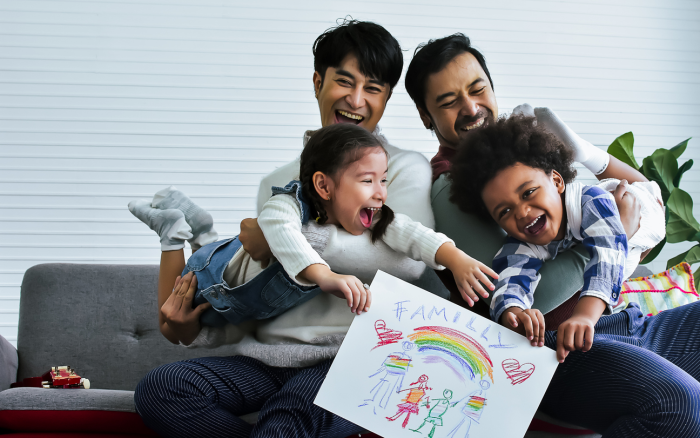Talking to kids about complex topics like gender identity and sexual orientation can feel overwhelming. As a parent or caregiver, you might feel unsure how to answer questions that your child might have, fear saying the “wrong” thing, or even feel embarrassed to broach the topic.
Rest assured, all of these feelings are completely normal. Still, these are important conversations to have with your children, regardless of whether your child is part of the LGBTQ+ community or not. Having these conversations can help support the mental health and well-being of young people who are members of the LGBT+ community.
If you want to talk to your child about gender identity and sexual orientation but aren’t sure how to start or what language to use, read on below.
Read More: 8 Ways for Kids to Celebrate Pride Month
The Dos and Don'ts of Discussing LGBTQ+ Issues with Children

Do educate yourself
If you aren’t a member of the LGBTQ community, there may be many terms and topics that you yourself are unfamiliar with. Don’t be afraid to educate yourself through reading, watching educational videos, or talking to LGBTQ+ people in your family or community.
Here are some common terms and topics that will be helpful for you to know:
Linguistic Career Options: Multiple Intelligences
The process of learning for human beings is quite complex since it differs from one individual to the next. Interestingly, some individuals learn best when presented with written or spoken material. Read More
- LGBTQ+ - An acronym that stands for Lesbian, Gay, Bisexual, Transgender, and Queer/Questioning. The plus symbol is commonly added to incorporate other identities that fall under this umbrella, such as asexual, aromantic, intersex, two-spirit, and many others.
- Lesbian - A woman who is sexually and romantically attracted to exclusively women.
- Gay - A man who is sexually and romantically attracted to other men.
- Bisexual - A person of any gender who is sexually and romantically attracted to more than one gender.
- Pansexual - A person of any gender who is sexually and romantically attracted to people regardless of their gender.
- Intersex - A person with biological sex characteristics that are not easily categorized as male or female. For example, an intersex person might be born with genitalia that is not clearly a penis or a vagina. Estimates state that around 1.7% of the population falls under the intersex umbrella.
- Gender identity - A person’s internal sense of their gender, whether male, female, transgender, cisgender, nonbinary, genderqueer, or something else.
- Gender expression - A person’s outward display of their gender identity, often through things like clothing, hairstyle, makeup, jewelry, and facial hair.
- Transgender - A person who does not identify with the gender they were assigned at birth. For example, someone who is assigned male at birth due to being born with male biology, but later identifies as a transgender woman. Someone who is transgender may or may not pursue medical intervention to more closely physically resemble their true gender identity.
- Cisgender - A person who does identify with the gender they were assigned at birth. For example, someone who is assigned male at birth due to being born with male biology, and continues to identify as male later in their life.
- Nonbinary - A person who identifies outside of the gender binary. A nonbinary person might feel like a mix of male and female, or feel like they don’t have a gender at all. A nonbinary person may use they/them pronouns.
- Gender non-conforming - A person whose gender expression falls outside of societal expectations for their gender, for example, a boy who enjoys wearing dresses and experimenting with makeup.
- Pronouns - The words used to refer to someone, which in English vary by gender. Examples include she/her/hers, he/him/hers, and they/them/theirs. When someone identifies as transgender or nonbinary, they may ask people to refer to them using different pronouns that affirm and align with their gender identity.
Don't be afraid to start the conversation
Create teachable moments with your child and ask them open-ended questions. You can start the conversation at any time, whether driving in the car, at the dinner table, or throughout the day. Ask your child open-ended questions to better understand what they know and think about LGBTQ+ issues (see below for specific prompts and talking points).
You can also start conversations with your child about things they see on TV, in books, or out in the world. Talk positively about all of the diversity that you and your child observe as you go about the world, and answer your child’s questions to the best that you’re able to.
Do use language intentionally

Gendered language is all around us in ways we might not even realize. Phrases like “boys will be boys” and “acting ladylike” can reinforce gender roles in ways that create rigidity of gender expression. You can also do this by avoiding gendered descriptors when possible, such as saying “firefighter” instead of “fireman” or “letter carrier” instead of “mail man.”
Also, don’t be afraid to use clinical terms for genitalia (e.g., penis, vulva) when talking to your children, instead of more ambiguous terms like “private parts”. In fact, outside of LGBTQ+ issues, researchers and experts support using clinical terms for genitalia with children as a way to foster body positivity and keep children safe from potential abuse.
Don't assume your child is straight and cisgender
Given the fact that about 7% of the population identifies as LGBTQ+, and numbers are even higher among younger generations, there is a chance that your child might grow up to be a member of the LGBTQ+ community.
Avoid using language that assumes your child’s gender identity and sexual orientation. Remain open to whoever your child might be when they grow up.
Do believe what your child tells you
If your child comes to you and tells you that they are gay or transgender, the most important thing you can do is believe them. You may think that a child is too young to know that they are gay or transgender, but research shows that most transgender children have a sense of their true gender identity by their preschool years.
If your child comes out to you, tell them that you love them and will support them. Also, consider seeking support groups or resources through organizations like PFLAG.
Talking Points by Age

Regardless of your child’s age, you want to approach discussing LGBTQ+ topics in ways that are age-appropriate. Here are some talking points you can use depending on your child’s age.
0 to 5 years old
- “Did you know that there are many different kinds of families? Some kids have a mom and a dad, two moms, two dads, or live with someone else.”
- “Lots of boys have penises, but some don’t. Lots of girls have vulvas, but some don’t.”
- “Some people think that only girls should cook and clean, but in our house, everyone has a way to contribute to the family.”
6 to 11 years old
- “When you grow up, you might decide to marry a boy or a girl or someone who isn’t a boy or a girl. Or you might decide that you don’t want to marry anyone! Whatever you decide to do, I love you and support you.”
- “Cousin Sam came out as transgender, which means we’re going to refer to Sam as he and him instead of she and her. When Sam was born, we all thought he was a girl, but now that he’s old enough he’s told us that he’s a boy! Do you have any questions about that?"
12+ years old
- “Someone might decide to cut their hair short because they like it short or because they want to feel more masculine. Someone might start wearing dresses and makeup because they like to feel more feminine. Do you like to feel masculine, feminine, or somewhere in between?”
- “I saw that your classmate Sarah came out as a lesbian! How awesome for her. What do you think about that?”
No matter your child’s age or identity, what’s most important is that they know you support them, always. All kids need to know that they can come to their parents with new questions and share the important parts of their lives. Kids should feel secure that no matter how they define themselves, you will continue listen to them, to learn, and to love them.



